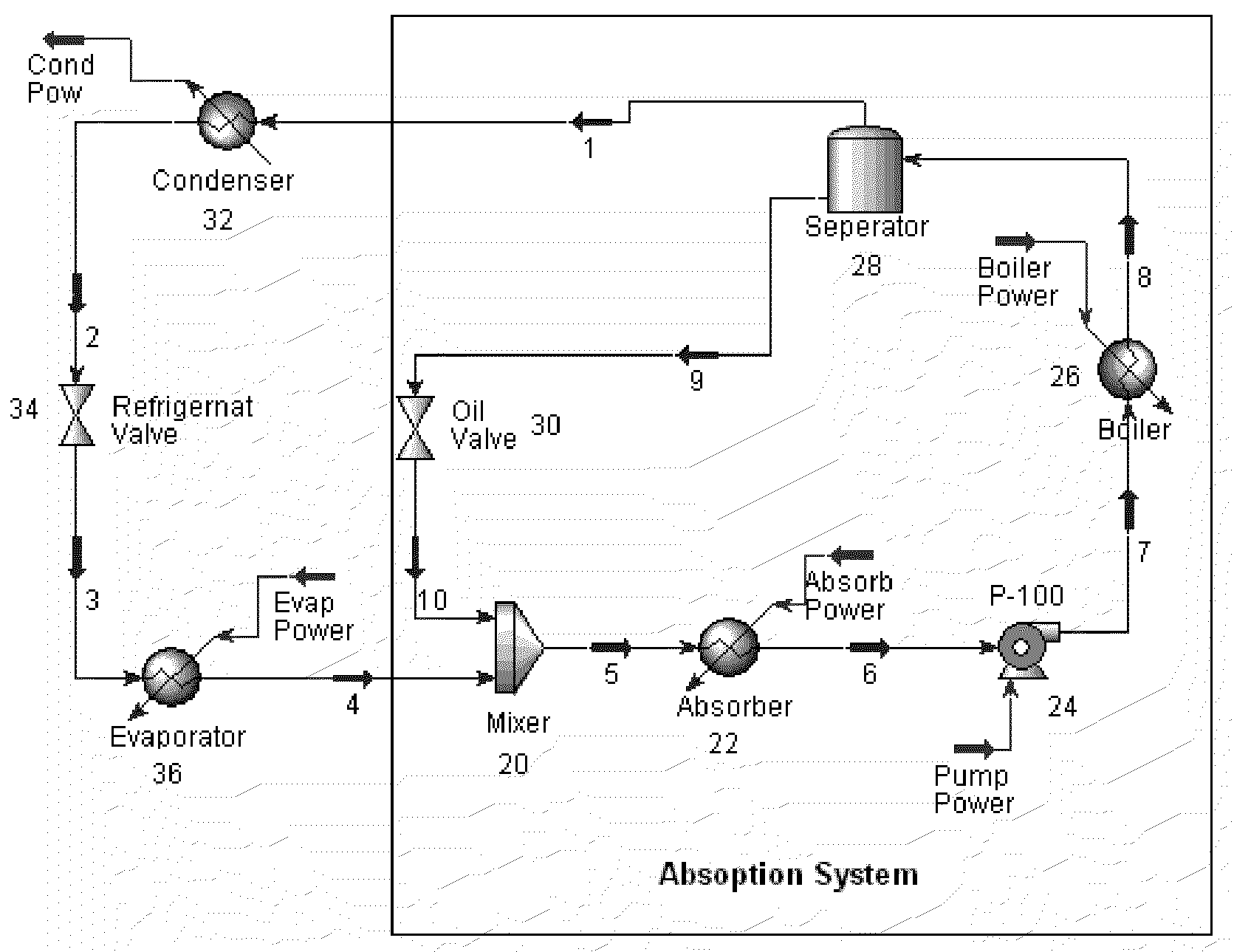Absorption refrigeration cycles using a lgwp refrigerant
a technology of absorption refrigeration and refrigerant, applied in the direction of refrigeration components, domestic cooling devices, lighting and heating devices, etc., can solve the problems of increasing and achieve the effect of reducing the cost of such systems
- Summary
- Abstract
- Description
- Claims
- Application Information
AI Technical Summary
Benefits of technology
Problems solved by technology
Method used
Image
Examples
example 1
[0035]The solubility of trans-1,3,3,3-tetrafluoropropene (1234ze(E)) in Ford Motor craft oil (a PAG refrigerant compressor oil meeting Ford specification No. WSH-M1C231-B) was measured by means of a micro-balance. The solubility that was measured along with the correlation of the data using the Non-Random Two Liquid (“NRTL”) activity coefficient model (Renon H., Prausnitz J. M., “Local Compositions in Thermodynamic Excess Functions for Liquid Mixtures,” AIChE J., 14(1), S.135-144, 1968)) is shown in FIG. 1. From these data it is seen that the Ford Motor Craft oil has nearly negligible vapor pressure and that the NRTL model can accurately represent the data.
example 2
[0036]The data from examples 1 was used to develop a single effect absorption cycle. A representative schematic of a single effect absorption system of this invention is illustrated in FIG. 2.
[0037]In FIG. 2, a Ford Motorcraft polypropylene glycol dimethyl ether-based oil from line 10 is mixed with a liquid 1234ze(Z) refrigerant from line 4 in a closed mixer 20 (which can be a simple “T” joint connecting lines 4 and 10 to line 5). The mixture in passed though line 5 to an absorber 22 where the gaseous 1234ze(Z) dissolves into the oil. The liquid mixture is passed though line 6 to pump 24 that pressurizes the mixture and passes the mixture through line 7 to heat exchanger / boiler 26. In boiler 26, heat is exchanged with the mixture. The source of that heat can be waste heat from an industrial operation (e.g., power generation) external to the heat exchanger. The temperature of the mixture is raised to a temperature where the 1234ze(Z) refrigerant can separate from the oil. The heated ...
example 3
[0046]A representative schematic of a double effect absorption is illustrated in FIG. 3.
[0047]In FIG. 3, a Ford Motorcraft polypropylene glycol dimethyl ether-based oil from line 17 is mixed with a liquid 1234ze(Z) refrigerant from line 4 in a closed mixer 40. The mixture is passed though line 5 to a first absorber 42 where the gaseous 1234ze(Z) dissolves into the oil. The mixture is passed though line 6 to first pump 44 that pressurizes the mixture and passes the mixture through line 7 to first heat exchanger / boiler 46. In boiler 46, heat is exchanged with the mixture. The source of that heat can be waste heat from an industrial operation (e.g., power generation) external to heat exchanger 46. The temperature of the mixture is raised. The heated mixture is removed through line 8 from heat exchanger 46 and introduced to a second mixer 48 where it is mixed with oil from line 15. The mixture from mixer 48 is taken through line 9 and introduced to second absorber 50 to ensure that all ...
PUM
 Login to View More
Login to View More Abstract
Description
Claims
Application Information
 Login to View More
Login to View More - R&D
- Intellectual Property
- Life Sciences
- Materials
- Tech Scout
- Unparalleled Data Quality
- Higher Quality Content
- 60% Fewer Hallucinations
Browse by: Latest US Patents, China's latest patents, Technical Efficacy Thesaurus, Application Domain, Technology Topic, Popular Technical Reports.
© 2025 PatSnap. All rights reserved.Legal|Privacy policy|Modern Slavery Act Transparency Statement|Sitemap|About US| Contact US: help@patsnap.com



